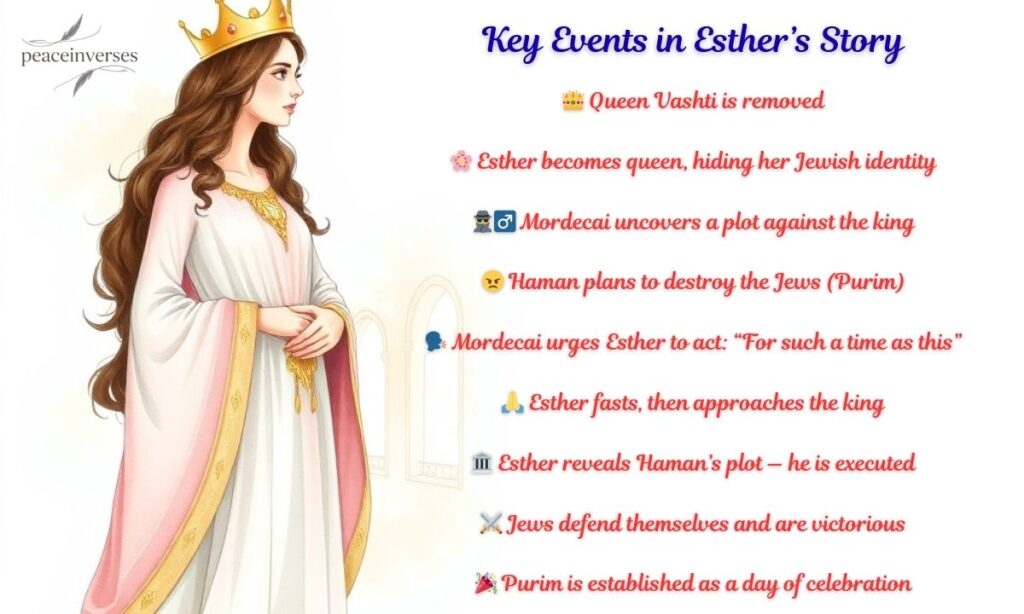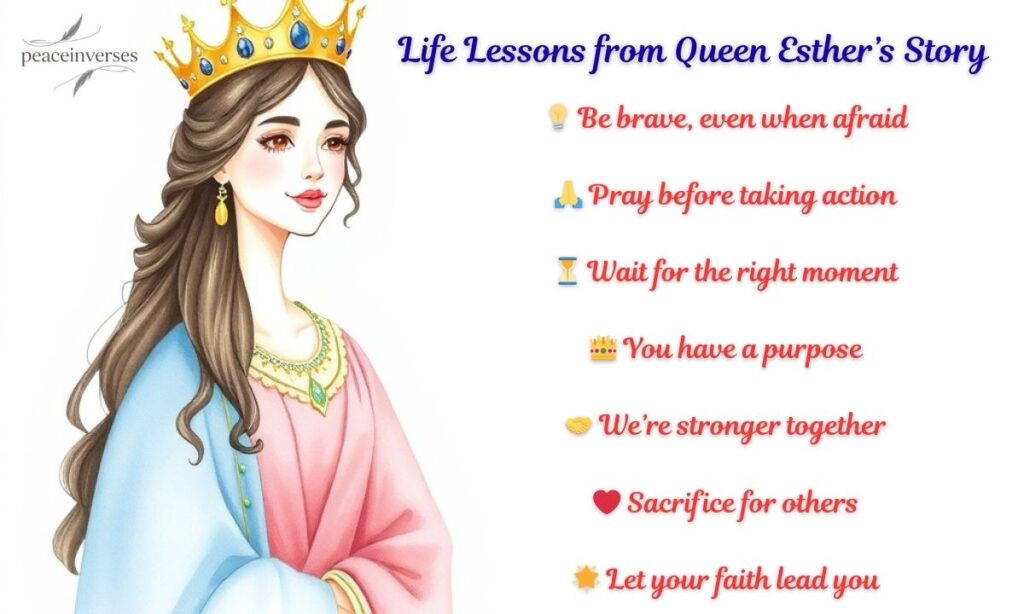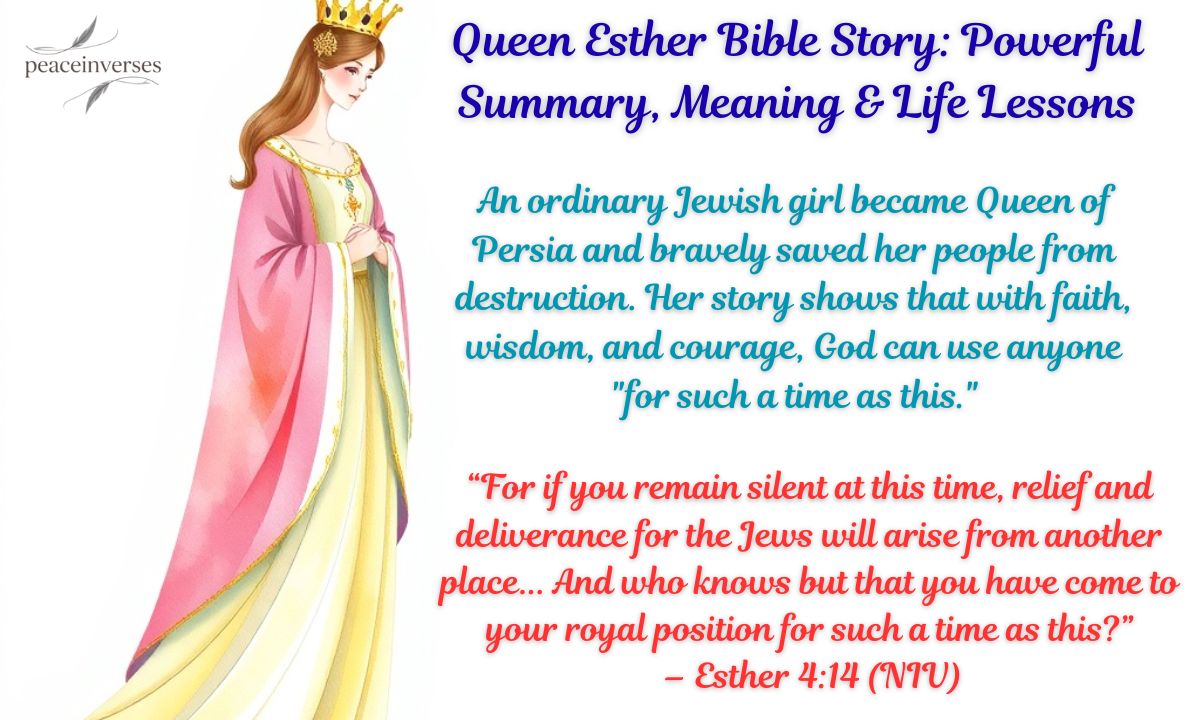The story of Queen Esther is more than ancient history—it’s a timeless lesson in courage, faith, and destiny. She was an ordinary woman placed in extraordinary circumstances. Through her bravery, an entire nation was saved.
When we read Esther’s story, we see themes of divine providence, hidden strength, and the power of unity. Her journey reminds us that God can use anyone, at any moment, for a greater purpose. Her life still speaks to us today.
Summary of the Queen Esther Bible Story
The story of Queen Esther is found in the Old Testament book of Esther. It tells how a young Jewish woman became queen in Persia. With courage and wisdom, she risked her life to save her people. Her story shows God’s unseen hand at work.
Historical and Biblical Context
The Book of Esther, found in the Jewish Ketuvim and the Christian Old Testament, tells the story of a Jewish orphan who became queen of Persia.
Set in Susa during the reign of King Ahasuerus (Xerxes I, 486–465 BC), it explains the origins of Purim, the festival of deliverance. Scholars believe it was written sometime between 460 and the 2nd century BCE.
Though God’s name is never mentioned, His providence shapes every event. From Esther’s rise to power to the survival of her people, divine guidance is evident.
The Greek Septuagint even adds extra religious verses, considered apocryphal in Jewish and Protestant traditions, but included in Catholic and Orthodox Bibles.
Key Events in Esther’s Story

- Queen Vashti is deposed for refusing King Ahasuerus (Esther 1).
- Esther, raised by her cousin Mordecai, becomes queen while hiding her Jewish identity (Esther 2).
- Mordecai exposes an assassination plot and earns recognition.
- Haman, angered by Mordecai’s refusal to bow, secures a decree to destroy all Jews by casting lots (purim) (Esther 3).
- Mordecai urges Esther to act, reminding her she may be queen “for such a time as this” (Esther 4:14).
- After fasting and prayer, Esther approaches the king uninvited and holds two banquets (Esther 5–7).
- Esther reveals her identity and exposes Haman’s plot; Haman is executed on the gallows he built for Mordecai.
- A new decree allows the Jews to defend themselves, and they win victory (Esther 8–9).
- The Feast of Purim is established to celebrate deliverance, and Mordecai is promoted (Esther 9:20–32).
The story of Esther is filled with courage, reversal, and divine timing. What began with fear of destruction ended in hope and celebration. Esther’s bravery not only saved her people but also established a lasting tradition. Her legacy continues through the Feast of Purim.
Meaning of the Queen Esther Bible Story

The story of Queen Esther carries deep spiritual meaning. It reveals God’s providence even when His name is not spoken. It teaches courage, sacrifice, and the value of unity. Her life shows how ordinary people can serve extraordinary purposes.
Divine Providence in Esther’s Narrative
Though God’s name is never mentioned in the book, His providence is everywhere. Esther’s rise to the throne was no accident. Mordecai’s discovery of the assassination plot was not coincidence. Even the sleepless night of the king played a role in saving the Jews.
This reminds us that God often works silently behind the scenes. His guidance is hidden but sure. People usually miss that Esther’s story shows how divine plans unfold without miracles. Ordinary choices and timing reveal God’s invisible hand. He uses people and events to accomplish His will.
“God is always working, even when He seems silent.”
Courage and Faith
Esther showed great courage when she entered the king’s presence uninvited. Doing so could have meant death. She asked her people to fast and pray for her, showing reliance on faith before action. Her famous words, “If I perish, I perish,” display complete trust.
Her bravery reminds us that faith is not absence of fear but strength to act in spite of it. Many forget that Esther waited patiently for the right moment to speak. Her wisdom in timing her requests shows faith paired with discernment. Courage and faith together became her strength.
“Courage isn’t the absence of fear—it’s obedience in spite of fear.”
Reversal of Destiny
One of the strongest themes in Esther is reversal. Haman planned Mordecai’s death but was executed on the gallows he built. The decree to kill the Jews was overturned, giving them power to defend themselves. What began in despair ended in celebration.
This reversal shows God’s justice at work. People often overlook that Esther’s story is a reminder of hope in dark times. No matter how powerful evil seems, God can change the outcome. The weak are lifted, and the proud fall.
“Weeping may endure for a night, but joy comes in the morning.” – Psalm 30:5
Unity and Jewish Identity
The story also highlights the power of unity. Esther asked her people to fast and pray together. Their shared faith and identity became their strength. The victory was not hers alone but belonged to the entire Jewish community.
This unity birthed the Feast of Purim, still celebrated by Jews today. It preserves memory, identity, and gratitude for deliverance. Many don’t realize how Esther’s story shaped Jewish culture. It shows that unity in faith can turn survival into lasting strength.
Life Lessons from Queen Esther’s Story

The story of Esther is more than history; it is a guide for life. Her courage and wisdom offer lessons we can live by today. From hidden strength to unity and hope, her example shines bright. These truths still speak powerfully to us.
Believe in Your Hidden Powers
Esther was an orphan with no status, yet she became queen. She discovered her hidden strength at the right time. Often, we don’t realize the gifts God has placed inside us. Like Esther, our true power may appear when challenges arise.
This lesson reminds us not to underestimate ourselves. People usually miss that Esther had both beauty and wisdom, a rare combination. God equips us in ways we don’t see until needed.
“The Lord is my strength and my shield.” (Psalm 28:7)
Embrace Your Destiny
Esther’s destiny was greater than royalty—it was to save her people. Mordecai reminded her she was chosen “for such a time as this.” Her story teaches us to embrace the calling God places before us.
Often we fear our purpose, but God’s plan is bigger than our fears. People don’t realize Esther was hesitant at first. Yet destiny required courage and obedience.
“For if you remain silent at this time, relief and deliverance… will arise from another place.” (Esther 4:14)
Let Your Inner Beauty Shine
Esther’s outer beauty gained the king’s attention, but her inner beauty won favor. She was gentle, wise, and humble. Her story teaches us that character shines brighter than appearance.
People usually miss that Esther asked for nothing extra when prepared for the king. She relied on grace, not wealth or charm. True beauty is found in a faithful heart.
“Charm is deceptive, and beauty is fleeting; but a woman who fears the Lord is to be praised.” (Proverbs 31:30)
Be Principled
Esther stood firm in her values, even when afraid. She sought God through fasting before acting. Principles guided her more than comfort or fear. Her story shows that values rooted in faith bring strength.
People often forget Esther’s patience and timing were principles too. She didn’t rush to expose Haman but acted wisely. Principles guide decisions in the right season.
We’re Stronger Together
Esther didn’t act alone; she asked her people to fast and pray. This shows the power of community support. Together, they overcame fear and destruction.
People overlook how collective prayer moved hearts and changed outcomes. Esther’s story reminds us that unity creates strength beyond individuals.
“For where two or three gather in my name, there am I with them.” (Matthew 18:20)
Unity as Strength
The Jews defended themselves because they stood together. Their unity turned weakness into victory. Esther’s leadership worked because her people acted in harmony.
The Feast of Purim still celebrates this unity. Many don’t realize it preserved Jewish identity for centuries. Unity is not just survival—it is lasting strength.
Turn to God in Trouble
Before Esther acted, she turned to God with fasting and prayer. Trouble became the moment to seek divine help. Her example shows that prayer prepares the heart for bold steps.
People forget fasting wasn’t only hers but for the whole community. Seeking God together gave power and courage. Trouble is the doorway to deeper trust in Him.
“Call upon me in the day of trouble; I will deliver you.” (Psalm 50:15)
Take the Lead in Action
Esther didn’t just pray—she acted. She went before the king, knowing the risks. Leadership often means stepping forward when others hesitate.
Many don’t realize Esther planned carefully, hosting banquets before speaking. Leadership requires strategy as well as bravery. Action backed by wisdom changes history.
Prepare to Make Sacrifices
Esther knew her choice could mean death. She accepted sacrifice for her people’s sake. True love and leadership require a willingness to give.
People often miss how Esther laid aside her comfort as queen. Her sacrifice reminds us that blessings come with responsibility.
“Greater love has no one than this: to lay down one’s life for one’s friends.” (John 15:13)
Courage Over Comfort
Esther chose courage when silence meant safety. She risked everything because her people’s lives mattered. This lesson shows that faithful courage is greater than personal ease.
Her words, “If I perish, I perish,” reveal complete trust. People don’t realize how rare such bravery was for a woman in her time. Courage becomes legacy when chosen over comfort.
Never Lose Hope
The Jews faced death, yet God turned despair into deliverance. Esther’s story reminds us to never lose hope. What begins in sorrow can end in joy.
Many overlook that Purim became a festival of hope renewed. God’s hand reversed the enemy’s plans. With Him, hope is never lost.
“Weeping may endure for a night, but joy comes in the morning.” (Psalm 30:5)
Frequently Asked Questions
Who Was Queen Esther in the Bible?
Esther, originally named Hadassah, was a Jewish orphan who became queen of Persia and saved her people from genocide through her courage and faith.
What Is the Main Message of the Queen Esther Story?
The story emphasizes divine providence, courage, and obedience, showing how God uses ordinary people for extraordinary purposes, even when unseen.
Why Is God’s Name Not Mentioned in the Book of Esther?
Though God’s name is absent, His providence is evident in every event, teaching that He works behind the scenes to fulfill His plans.
What Is Purim and Its Connection to Esther?
Purim is a Jewish festival celebrating the Jews’ deliverance from Haman’s plot, established in the Book of Esther to honor God’s faithfulness and Esther’s bravery.
What Does “For Such a Time as This” Mean in Esther’s Story?
This phrase (Esther 4:14) suggests Esther was divinely positioned as queen to save her people, reminding us our roles may have a greater purpose.\
Conclusion
The Queen Esther Bible story is a timeless narrative of courage, faith, and divine providence, illustrating how an ordinary Jewish orphan became a queen who saved her people from genocide. Through strategic wisdom and bold action, Esther transformed a dire situation into a triumph, establishing the joyous festival of Purim.
Her story affirms that God orchestrates events behind the scenes, using anyone willing to trust Him.Esther’s journey inspires us to embrace our unique callings, act courageously against injustice, and foster unity in community.
Her documented legacy of hope encourages perseverance, even in seemingly hopeless situations. We, too, are reminded to trust in God’s unseen hand, positioned “for such a time as this.”

Muhammad Shoaib is a passionate faith-based writer with over 10 years of experience in creating meaningful content centered around prayers, Bible meanings, scriptural teachings, and heartfelt wishes. He is the lead writer at PeaceInVerses.com, where he shares spiritual insights and uplifting messages to guide and inspire readers on their faith journey.

